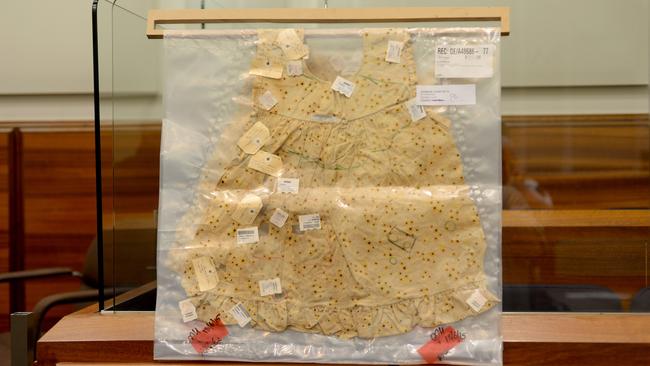Piece of pyjama fluff not enough to convict man accused of murder of Louise Bell, Dieter Pfennig, court hears
A PIECE of fluff on a pyjama top is not enough to convict a man of the infamous Louise Bell abduction and murder, a court has heard.
SA News
Don't miss out on the headlines from SA News. Followed categories will be added to My News.
- Pfennig pleads not guilty to abducting and murdering Louise Bell
- Louise Bell murder accused suffers heart attack in prison
- Court hears lab finds ‘billion to one’ DNA match in Louise Bell murder case
A PIECE of fluff on a pyjama top is not enough to convict a man of the infamous Louise Bell abduction and murder, a court has heard.
In closing submissions on Monday, counsel for Dieter Pfennig urged the Supreme Court to find their client not guilty of a crime that has mystified South Australia for 30 years.
Paul Charman, for Pfennig, said only one DNA sample in the entire case allegedly matched his client while others were inconclusive or specifically excluded him from the case.
He said prosecutors had also failed to disprove any number of innocent explanations for how the “minuscule” amount of DNA — if it indeed belonged to Pfennig — ended up on Louise’s pyjamas.
“Really, the DNA case is based on a piece of fluff ... all of the other DNA samples tested are either inconclusive or exclude Pfennig,” he said.
“These are significant differences, such that the overall effect of the DNA evidence is unreliable to the fact you cannot find Pfennig’s DNA was on the pyjama top.”
Pfennig, 67, has denied abducting Louise, 10, from her Hackham West home in January 1983 and murdering her some time before March 1 that year.
He is already serving a life sentence for the 1989 murder of Michael Black, 10.
Louise Bell’s body has never been recovered.
Neither child’s body has ever been recovered — witnesses claim Pfennig has said they are buried together — but Louise’s earrings were found after her disappearance.

Central to the prosecution case is a DNA sample taken from Louise’s torn, discarded pyjama top, found days later, which analysis suggests is a one in one billion match to Pfennig.
Defence counsel have fought that assertion — based on thousands of pages of scientific evidence written in Dutch — throughout the trial.
At one stage, they asked unsuccessfully for a six-month adjournment and another $250,000 in legal aid funding to challenge the evidence.
On Monday, Mr Charman said prosecutors had led much evidence on the DNA sample, but little on how it came to be on the top.
He said that issue — known in science as “transfer” — was of crucial importance.
“The prosecution must eliminate the reasonable possibility that Pfennig’s DNA got onto the pyjama top at any other time than the abduction of Louise Bell,” he said.
“We say they led a significant amount of evidence as to opportunities for transfer prior to the abduction.”
Mr Charman said the trial had heard Louise attended the same school as Pfennig’s daughter, that both had gone to the same pool party, and that their families frequented the same community hall.

He said that, given the lack of knowledge in the global scientific community about transfer, “a thread” boasting Pfennig’s DNA could have made it onto Louise during one of those occasions and then subsequently onto her pyjama top.
Mr Charman asked the court to remember that DNA testing on Louise’s windowsill, and other parts of the crime scene, did not match his client.
He also reminded Acting Justice Michael David that several different scientists came to different conclusions about the DNA sample from the top, leading to it being sent overseas in the first place.
“There are inconsistencies and contradictions in the results due to different tests, different labs, different situations and different software,” he said.

“While scientists say they can justify, from a scientific point of view, the varied results, that doesn’t mean Your Honour can accept they prove the DNA case beyond reasonable doubt.
“It’s not an exact science, it’s complex and difficult, and the best the prosecution can do is show you a snapshot of what scientists are thinking at the time.”
Mr Charman said three decades of investigation into the high-profile case had yielded just two DNA samples allegedly linked to Pfennig — the fluff and a “tape lift” from the top.
“The prosecution suggests Louise Bell was taken from her bedroom (but says) how that actually occurred is a mystery,” he said.
“But there’s no DNA, consistent with Pfennig, inside the bedroom or the windowsill ... the DNA sample from the flyscreen specifically excludes him.
“It’s fundamentally inconsistent with this girl being taken from her bedroom, and carried six minutes away, that the only DNA evidence would be a piece of fluff and a tape lift.
“There still has to be DNA somewhere and there’s none — and that gap is not defence’s problem, it’s the prosecution’s problem.”
The trial, which has proceeded in the absence of a jury, is expected to conclude tomorrow with final defence submissions.
Acting Justice David will then adjourn to a date to be set, at which time he will hand down his verdict.


